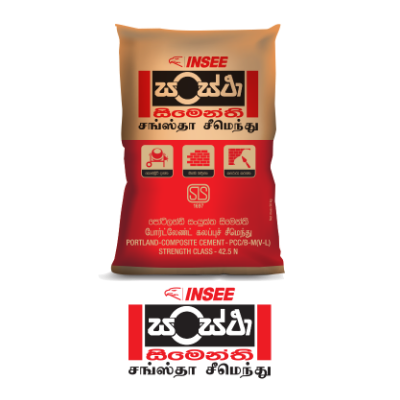
INSEE Sanstha
Sustainable High Performing Cement
INSEE SANSTHA PORTLAND COMPOSITE CEMENT is the result of years of research and development, engineered with INSEE’s trademarked newly introduced SmartActTM Complex Organo-Mineral Technology. It is a unique superior blended cement with up to 35% clinker replaced with a composition of more than one cementitious mineral addition under the newly established Sri Lanka Standard SLS 1697:2021 Specification for Portland-Composite Cement (PCC). INSEE SANSTHA PORTLAND COMPOSITE CEMENT is produced as two variants; a ternary composition Combining of either fly ash or slag with high-grade calcium carbonate.
Producing compressive strength equivalent to that of OPC among other characteristics, INSEE SANSTHA PORTLAND COMPOSITE CEMENT comes strongly recommended for projects that require strength development at all ages. Optimum particle size distribution and high packing density of INSEE SANSTHA PORTLAND COMPOSITE CEMENT ensures the consumption of less mixing water, while its reduced clinker percentage results in the reduction of the carbon footprint of the cement product, making INSEE SANSTHA PORTLAND COMPOSITE CEMENT more environmentally friendly than OPC.
Fact File
| Name : | INSEE Sanstha |
| Type : | Portland-Composite Cement |
| Sri Lankan Standard : | SLS 1697:2021 |
| Strength Class : | 42.5N/R |
| British Standard : |
BS EN 197 CEM II-B/M |
Compatibility
INSEE SANSTHA is compatible with:
- Chemical Admixtures complying with BS EN 450-1:2014 and ASTM C494
- Ground Granulated Blast Furnace Slag (GGBS) complying with BS EN 15167-1:2006
- Silica Fume complying with BS EN 13263-1:2005+A1:2009
- Manufactured Sand (M-Sand) complying with BS EN 12620:2013
- Natural Sand, Quarry Sand and Offshore Sand complying with BS EN 12620:2013
Applications
INSEE SANSTHA is used for:
- Individual home building with high workable and durable concrete
- Structures requiring superior strength, water tightness with extended service life
- Concrete roads
- Architectural and visually appealing concrete requiring high quality surface finishes
- Masonry and decorative constructions due to superior workability with a smoother and aesthetic finish
- Landscaping concrete applications
Features and Benefits
Sustainable High Performing Cement
While OPC undergoes one reaction to form calcium-silicate hydrate gel (C-S-H) – the glue that holds concrete together – INSEE PCC CEMENT undergoes THREE reactions with INSEE’s trademarked SmartActTM Technology, promoting refinement of the pore structure of matured concrete. INSEE PCC CEMENT first undergoes the hydration reaction similar to OPC forming calcium silicate hydrate (C-S-H) as well as portlandite [Ca(OH)2]. This is followed by the pozzolanic reaction like in Blended Hydraulic Cements (BHC), where the presence of cementitious additions such as fly ash or slag in the ternary composition react with the portlandite created from the first reaction to form additional C-S-H, further decreasing porosity, capillary pores and void spaces in the concrete, thus greatly reducing permeability and increasing strength and durability in the structure. A third nucleation reaction unique to INSEE PCC CEMENT further accelerates the hydration and formation of additional carbonate aluminate hydrate (C-A-H) growing between the capillarity pores, resulting in a denser microstructure as well as higher strength and durability at each level of maturity.
Higher Sulphate and Chloride Resistance
The very dense microstructure and low porosity makes INSEE PCC CEMENT the ideal product to be used in constructions in aggressive environments that contain sulphate in ground water or soils, salts and acids or any other exposure conditions found across Sri Lanka that harm and/or accelerate the decaying process of concrete structures.
Alkali Aggregate Reaction (AAR) Resistance
Fly ash and slag as cementitious constituents used in INSEE PCC CEMENT reduces the alkali aggregate reaction (AAR) by bonding chemically the soluble alkalis in the cement, thus preventing the possibility of forming expansive alkali gels with potential reactive aggregates in the concrete microstructure, resulting in cracks formation and concrete deterioration.
Mass Pouring
For larger areas of concreting, high internal temperatures can cause adverse reactions such as internal cracking resulting from thermal contractions and Delayed Ettringite Formation (DEF). Featuring low heat of hydration development at early age, INSEE PCC CEMENT is highly recommended for mass concrete works, and the preferred solutions in hot weather conditions especially in tropical countries.
Environmentally Friendly
Unlike traditional OPC which consists of more than 95% clinker - the main cement constituents that emits CO2 during its production, the new INSEE PCC contains up to 35% less clinker in its composition. INSEE PCC CEMENT also has an optimum particle size distribution with a high packing density which results in superior fresh and hardened concrete properties with high water retention, thus reducing the required mixing water to achieve the desirable workability with potential mix design and cost optimisation.
Superior Workability
The finely engineered particles of high-grade calcium carbonate (CaCO3), finely blended slag, and spherical fly ash particles all act as lubricant, reducing water demand for the mixture while also increasing the fluidity and workability of the cement. Now, with proven superior workability above all other cement products in the market, INSEE PCC CEMENT enables masons to achieve a much smoother and highly aesthetic finish for masonry work. This property also results in increasing the pumpability of concrete.
Water Protect
Rainwater enters concrete through open pores and capillary voids. The new INSEE PCC CEMENT formulation results in a very dense and impermeable concrete microstructure with very less voids and connected capillary pores. The optimal particle size distribution also means maximum packing density of the concrete, offering complete protection against water penetration and infiltration. This leads to stronger, more water resistant and high standard living homes, with INSEE PCC CEMENT addressing the key challenges of rainwater penetration and ingress in concrete structures that are of significant concern for homeowners.









